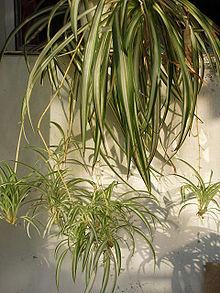- Chlorophytum
-
Chlorophytum 
Chlorophytum comosum 'Vittatum' Scientific classification 
Kingdom: Plantae clade: Angiosperms clade: Monocots Order: Asparagales Family: Asparagaceae Subfamily: Agavoideae Genus: Chlorophytum
Ker Gawl.Species About 200-220, including:
Chlorophytum amaniense
Chlorophytum arundinaceum
Chlorophytum bichetii
Chlorophytum borivilianum
Chlorophytum capense
Chlorophytum comosum
Chlorophytum heynei
Chlorophytum hoffmannii
Chlorophytum inornatum
Chlorophytum macrophyllum
Chlorophytum nepalense
Chlorophytum orchidastrum
Chlorophytum tuberosumChlorophytum (pronounced /ˌklɒrɵˈfaɪtəm/)[1] is a genus of about 200-220 species of evergreen perennial flowering plants in family Asparagaceae, subfamily Agavoideae,[2] native to the tropical and subtropical regions of Africa and Asia.
They grow to 10–60 cm tall, with a rosette of long, slender leaves 15–75 cm long and 0.5–2 cm broad, growing from a thick, fleshy rhizome. The flowers are small, usually white, produced on sparse panicles up to 120 cm long; in some species the panicle also bears plantlets, which take root on touching the ground.
Chlorophytum comosum, also called the Spider Plant, a native of South Africa, is a very popular houseplant in its variegated form 'Variegatum'.
Chlorophytum borivilianum is a native of India, used and grown as a medicinal plant.
References
- ^ Sunset Western Garden Book, 1995:606–607
- ^ Stevens, P.F. (2001 onwards), Angiosperm Phylogeny Website: Asparagales: Agavoideae, http://www.mobot.org/mobot/research/apweb/orders/asparagalesweb.htm#Agavaceae

This Asparagales article is a stub. You can help Wikipedia by expanding it.


